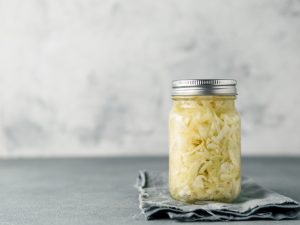Does the term “fermented foods” make you think of sauerkraut, yogurt, kimchi, pickles, sourdough bread, or kombucha?
What is a fermented food?
Fermentation occurs when enzymes or bacteria convert to sugar in food to either alcohol or acid. [1] In simple terms, food is broken down or converted into a new food product with brand new flavors, textures, and colors!
Some foods naturally contain organisms needed to undergo fermentation (think sauerkraut) while others need a starter culture to begin the process (think kombucha). [2] Conditions such as temperature and light affect this process as well. However, optimal conditions vary depending on the food that is being fermented. [3] [4]
Fun fact: Did you know that sauerkraut is cabbage that has undergone fermentation? And kimchi, a traditional Korean side dish, is a mix of fermented vegetables and spices! Click here to learn more about kimchi.

Are fermented foods good for you?
One of the reasons fermented foods have become so popular is their proposed health benefits. Evidence suggests that certain compounds found in fermented foods may:
Fermented foods contain probiotics. [6] Probiotics are live bacteria that improve gut health. Some fermented foods that commonly contain probiotics are sauerkraut, yogurt, kefir, and kombucha.
However, not all fermented foods contain probiotics as processing techniques like canning may make them inactive. [7] If you want to ensure that the fermented foods that you buy contain probiotics, look for the phrase “contains live and active cultures” on the container.

You can do it too!
Fermented foods are not just a specialty item that can be found at the grocery store. Fermentation is a relatively cheap process that you can master yourself using research-based methods. The result will be tasty, colorful, shelf-stable produce that you will enjoy for months to come.
Use the links below to check out a few recipes from the National Center for Home Food Preservation:
Dill Pickles: https://nchfp.uga.edu/how/can_06/dill_pickles.html
Sauerkraut: https://nchfp.uga.edu/how/can_06/sauerkraut.html

Written by Darci Bell, RDN, LD, Ph.D. Student | Edited by Laurel Sanville, MS, RDN, LD
References:
- Bell, Ferrão, Pimentel, Pintado, and Fernandes. One health, fermented foods, and gut microbiota. Foods 2018; 7(195): 1-17.
- Dimidi, Cox, Rossi, and Whelan. Fermented foods: Definitions and characteristics, impact on the gut microbiota and effects on gastrointestinal health and disease. Nutrients 2019; 11: 1-26.
- Dragone, Mussato, Almeida e Silva, and Teixeira. Optimal fermentation conditions for maximizing the ethanol production by Kluyveromyces fragilis from cheese whey powder. Biomass and Bioenergy 2011; 35(5): 1977-82.
- Henderson et al. Fermentation temperature modulate phosphatidylethanolamine and phosphatidylinositol levels in the cell membrane of Saccharomyces cerevisiae. Applied and Environmental Microbiology 2013; 79(17): 5345-56.
- Sanlier, Gokcen, Sezgin. Health benefits of fermented foods. Critical Reviews in Food Science and Nutrition 2019; 59(3): 506-527.
- Gupta and Abu-Ghannam. Probiotic fermentation of plant-based products: Possibilities and opportunities. Critical Reviews in Food Science and Nutrition 2012; 52(2): 183-199.
- International Scientific Association for Probiotics and Prebiotics. 2019. Retrieve from: https://isappscience.org/for-scientists/resources/fermented-foods/. Accessed on January 22, 2020.